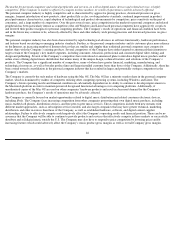Apple 2005 Annual Report Download - page 39
Download and view the complete annual report
Please find page 39 of the 2005 Apple annual report below. You can navigate through the pages in the report by either clicking on the pages listed below, or by using the keyword search tool below to find specific information within the annual report.
Expansion of the Retail segment has required and will continue to require a substantial investment in fixed assets and related infrastructure,
operating lease commitments, personnel, and other operating expenses. Capital expenditures associated with the Retail segment were $132
million in 2005, bringing the total capital expenditures since inception of the Retail segment to approximately $529 million. As of
September 24, 2005, the Retail segment had approximately 3,673 employees and had outstanding operating lease commitments associated with
retail store space and related facilities of approximately $606 million. The Company would incur substantial costs should it choose to terminate
its Retail segment or close individual stores. Such costs could adversely affect the Company’s results of operations and financial condition.
Gross Margin
Gross margin for each of the last three fiscal years are as follows (in millions, except gross margin percentages):
Gross margin increased in 2005 to 29.0% of net sales from 27.3% of net sales in 2004. The Company’
s gross margin during 2005 increased due
to more favorable pricing on certain commodity components including LCD flat-panel displays and DRAM memory; an increase in higher
margin software sales; a favorable shift in direct sales related primarily to the Company’s Retail and online stores; and higher overall revenue
that provided for more leverage on fixed production costs. These increases to gross margin were partially offset by an increase in lower margin
iPod sales.
The Company anticipates that its gross margin and the gross margin of the overall personal computer and consumer electronics industries will
remain under pressure in light of price competition, especially for the iPod product line. The Company expects gross margin percentage to
decline in the first quarter of 2006 primarily as a result of a shift in the mix of revenue toward lower margin products such as the iPod and
content from the iTunes Music Store.
The foregoing statements regarding the Company’s expected gross margin are forward-looking. There can be no assurance that current gross
margins will be maintained or targeted gross margin levels will be achieved. In general, gross margins and margins on individual products,
including iPods, will remain under significant downward pressure due to a variety of factors, including continued industry wide global pricing
pressures, increased competition, compressed product life cycles, potential increases in the cost and availability of raw material and outside
manufacturing services, and potential changes to the Company’s product mix, including higher unit sales of consumer products with lower
average selling prices and lower gross margins. In response to these downward pressures, the Company expects it will continue to take pricing
actions with respect to its products. Gross margins could also be affected by the Company’s ability to effectively manage product quality and
warranty costs and to stimulate demand for certain of its products. Due to the Company’s significant international operations, financial results
can be significantly affected in the short-term by fluctuations in exchange rates.
37
September 24,
2005
September 25,
2004
September 27,
2003
Net sales
$
13,931
$
8,279
$
6,207
Cost of sales
9,888
6,020
4,499
Gross margin
$
4,043
$
2,259
$
1,708
Gross margin percentage
29.0
%
27.3
%
27.5
%
























